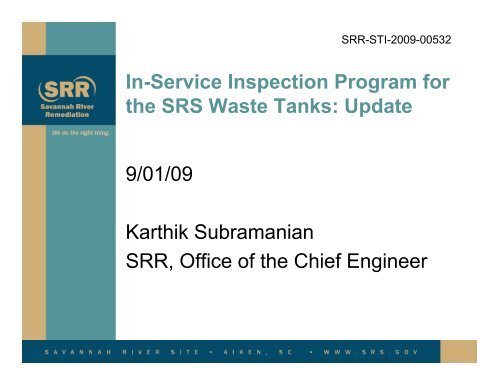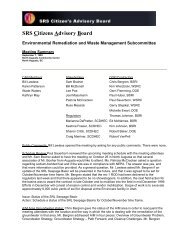In-Service Inspection Program for the SRS Waste Tanks ... - SRS CAB
In-Service Inspection Program for the SRS Waste Tanks ... - SRS CAB
In-Service Inspection Program for the SRS Waste Tanks ... - SRS CAB
Create successful ePaper yourself
Turn your PDF publications into a flip-book with our unique Google optimized e-Paper software.
SRR-STI-2009-00532<strong>In</strong>-<strong>Service</strong> <strong>In</strong>spection <strong>Program</strong> <strong>for</strong><strong>the</strong> <strong>SRS</strong> <strong>Waste</strong> <strong>Tanks</strong>: Update9/01/09Karthik SubramanianSRR, Office of <strong>the</strong> Chief Engineer1
Acronyms• SRR: Savannah RiverRemediation• SI: Structural <strong>In</strong>tegrity• ISI: <strong>In</strong>-<strong>Service</strong> <strong>In</strong>spection• Kgal: Thousands ofgallons• Mgal: Millions of gallons• SRNL: Savannah RiverNational Laboratory• SST: Single Shell Tank• DST: Double Shell Tank• VSC: Vapor SpaceCorrosion• GAO: GovernmentAccountability Office• DNFSB: Defense NuclearFacilities Safety Board• TSIP: Tank Structural<strong>In</strong>tegrity Panel• SCC: Stress CorrosionCracking• AUT: AutomatedUltrasonic <strong>In</strong>spection2
Safety/Security• SRR Committed toSafety and SecurityExcellence• Still THE priority• SRR will continue <strong>the</strong><strong>SRS</strong> safety tradition• Security is like safety:SRR will keep it frontand center3
Outline• Calendar Year 2008 <strong>In</strong>spection Results• <strong>Waste</strong> Tank Design• Structural <strong>In</strong>tegrity (SI) <strong>Program</strong>• Corrosion Control <strong>Program</strong>• <strong>In</strong>-<strong>Service</strong> <strong>In</strong>spection (ISI) <strong>Program</strong>• SRR <strong>Program</strong> Status4
CY2008 <strong>In</strong>spection Results• WSRC-STI-2009-00352, “Annual Radioactive<strong>Waste</strong> Tank <strong>In</strong>spection <strong>Program</strong> – 2008”• 6782 photographs• 1633 visual/video inspections• Two new leaksites identified– Tank 5 (during final cleaning) and Tank 12(duringwaste removal)– Consistent with known degradation mechanisms innon-compliant, old-style Type I/II tanks with partialsecondary containment– Specific response/communication plans during wasteremoval and cleaning activities5
<strong>Waste</strong> <strong>Tanks</strong>Type I (12)Old Style750 kgal1951-1953Type II (4)Old Style1.0 Mgal1955-1956Type IV (8)Old Style1.3 Mgal1956-1960Type III (27)New Style1.3 Mgal1966-1981• (24) Old Style <strong>Tanks</strong>– Type I/II: partial secondary containment• Routine visual inspections of annulus• Monitor and visually inspect duringwaste removal activities– Type IV: single shell tanks (SST)• Routine internal visual inspections– Up to 50 years old– Do not have full secondarycontainment– (2) have been closed– No active leaksites today• (27) New-Style <strong>Tanks</strong>– Full secondary containment– No leakage history– Receive all new waste– Used <strong>for</strong> all processing activities– Comprehensive inspection program• Visual inspections• Volumetric inspection6
Complex-Wide Tank Farm Structural<strong>In</strong>tegrity FocusHistory of Tank Farms SICorrosion TechnologyExchange (SRNL)TSIP Commissioned<strong>SRS</strong> SI Topical Report1s t TFA SI Wo rkshopDST ChemistryOptimization Wo rkshopDST Expert P anelCommissionedVSC Wo rkshop I3rd TFA SI Wo rkshopVSC Wo rkshop IIGAO Report o n Han<strong>for</strong>dSSTs1990 1992 1994 1996 1998 2000 2002 2004 2006 2008 2010DOE Order 435.1TSIP ReportDNFSB 2001-1RecommendationHan<strong>for</strong>d DST Liquid LevelWo rkshopTank SI Wo rkshopSST SI P anelCommissioned2nd TFA SI Wo rkshopHan<strong>for</strong>d Life ExtensionPanel8
Corrosion Control <strong>Program</strong>• Maintain corrosioninhibitors– Envelope of nitrite,hydroxide, nitrateconcentrations• Maintaintemperatures– Concentrationdependenttemperature limitsAnnulus(secondary)Tank WallTYPE III TANKNO LEAKSITESAnnulus(Primary)Tank Wall10
Comprehensive <strong>In</strong>spection<strong>Program</strong>• Visual Surveillance– Still photography – ( ~5000 photos/year)– Wide Angle– Direct– Video Camera <strong>In</strong>spections (over ~1000video/visual exams/year)• <strong>In</strong>-<strong>Service</strong> <strong>In</strong>spection <strong>Program</strong>– NDE inspections included remote automatedultrasonic (AUT) inspection supplemented byremote visual inspection.11
• Type I/II tanks– No active leaksitesComprehensive <strong>In</strong>spection<strong>Program</strong>– Use of conductivity probes in annulus– Routine visual inspections of annulus– Monitor and visually inspect during wasteremoval activities• Type III/IIIA tanks– Comprehensive visual inspection program– Comprehensive volumetric inspectionprogram12
• Visual evidence of changesin tank componentappearance– Leak sites– Corrosion– Abnormal conditionsVisual <strong>In</strong>spections13
Ultrasonic <strong>In</strong>spections• Historical Volumetric WallMeasurements– Data collection initiated in 1967– Collected over 24,000 spotmeasurements thru 1985• NEW PROGRAM 1 st CYCLECOMPLETED• All 27 Type III tanks inspected withnew program• Examinations look <strong>for</strong> wall thinning,pitting, and Stress Corrosion Cracking• Type II Tank 15 inspected twice• <strong>In</strong>spect primary and secondary walls• Formal methodology <strong>for</strong> disposition ofresults• Access thru small-diameterriser• On-board cameras14
Ultrasonic <strong>In</strong>spection of a Tank1 1(4 Strips)234Probe travels over1 mile during atank inspection15
1 st Cycle Baseline Data• Consistent with understanding ofwaste chemistry and knownmechanisms• One-riser inspections as likely tofind pitting as four-riserinspections• No reportable, service inducedindications (i.e., wall thinning,pitting, or cracking) on <strong>the</strong> primarytank wall.• Revealed incipient pitting and nonreportableindications on <strong>the</strong>interior of <strong>the</strong> few primary tankwalls.– Most are pre-service• Revealed reportable wallthickness and locally thin areas on<strong>the</strong> secondary wall and floor.<strong>In</strong>spection Year(FY) /<strong>In</strong>spection Type <strong>In</strong>cipient PittingTank # *<strong>In</strong>dicationsOne 0.35” diameter25 2004 / A pit 0.036” deep.Four 0.5” diameterpits 0.019 – 0.065”29 2006 / FS deep31 2003 / A32 2003 / FS49 2005 / A* FS = Full Scope A= AugmentedCommentsIsolated, broad shallowpittingIsolated, broad shallowpittingOne ~0.37” diameter Isolated, broad shallowpit 0.046” deep pittingThree pits, max0.75” diameter and Isolated, broad shallow0.055” deep pitting.A band of pitting ~85to 114 inches tankelevation. Up to 0.75”diameter and 0.040”deep.Broad shallow pitting16
Baseline Data: <strong>In</strong>cipient PittingDefinition• <strong>In</strong>cipient pitting is a termused to describe smallpit-like indications prior to<strong>the</strong>m becomingreportable or actionable• The term describes ashallow indication• The term does notnecessarily imply that <strong>the</strong>pit has recentlydeveloped or that it is stillgrowing• Many incipient pits mayhave developed preserviceTank 49200417
2 nd Cycle ISI Plan• Revised <strong>SRS</strong> ISI <strong>Program</strong> <strong>for</strong> waste tanks inspects all 27Type III/IIIA tanks– <strong>In</strong>cipient interior tank wall indications– Wall thickness of secondary– Knuckle region in select tanks– High stress region: Tank 50• Frequency– All 27 type III/IIIA tanks shall be inspected every 6-10 years– Tank 15 shall be inspected seven years after <strong>the</strong> most recentinspection– A <strong>for</strong>mal review of <strong>the</strong> ISI program shall be per<strong>for</strong>med everythree years• Acceptance Criteria outlines actions in response toindications consistent with national “Tank Structural<strong>In</strong>tegrity Panel” recommendations18
2009 Tank 29 <strong>In</strong>spection• Special inspection per<strong>for</strong>med on Tank 29to confirm assumption of circumferentialuni<strong>for</strong>mity of service-induced pitting• One-strip inspection covers all historicalinterfaces (e.g., liquid-air) known to be <strong>the</strong>highest risk areas <strong>for</strong> corrosion• Tank 29 inspected through all accessiblerisers (16) to provide <strong>the</strong> rigorous technicalbases prior to launching of <strong>the</strong> next cycleof inspections19
• Questions?21



